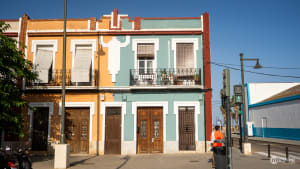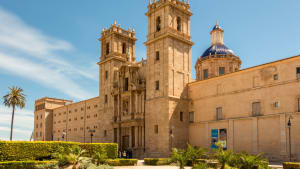
How to Plan Your Visit to Valencia During Fallas
A complete guide on everything you should know before visiting Valencia during Fallas. All the major events, the best time to come by, budget suggestions, and how to go about your accommodation. All the essentials for first-time visitors to the festival.
Planning Your Visit to Valencia During Fallas in a nutshell...
Fallas is Valencia’s spectacular UNESCO-recognized festival held in March, transforming the city into a vibrant celebration featuring nearly 800 satirical sculptures (ninots), daily fireworks displays, parades, music, and culminating in massive bonfires when all sculptures are ceremoniously burned.
The most spectacular events occur during Semana Fallera (March 14-19), with highlights including the Ofrenda de las Flores (flower offering), Nit del Foc (Night of Fire), and La Cremà (burning ceremony) between March 17-19, making this the ideal period to experience the festival’s pinnacle moments.
Visiting during Fallas requires advance planning (ideally a year ahead) as accommodation prices soar and availability becomes extremely limited. Budget approximately €40 daily for food and activities plus accommodation costs, and consider staying in central areas like Ciutat Vella or Eixample while utilizing Valencia’s excellent public transportation network to navigate the festival-filled city.
From our personal experience living through Valencia’s Fallas, these are all the things you need to know before visiting the city at the time of the festival.
We’ll explain what the celebration is all about, the most interesting events, and the ideal time to come to be able to see them all. But we’re also going to give you all the practical information you might need about Fallas.

How, when, and where to find accommodation, as well as budgeting tips and suggestions, so that you know what to expect for your holiday.
When to Visit
Valencia’s most famous and celebrated festival lasts a few weeks, but the most intense and noteworthy days are towards the end of Falles. This is known as the Semana Fallera or the days between the 14th and the 19th of March. This is when the fallas sculptures are finally installed all around the city.

The most spectacular events, as mentioned above, are the Ofrenda de las Flores, the Nit del Foc, and the Cremà. They all take place between the 17th and the 19th, so if you’re looking for a key time window, this is it.
If you’d like to know more about the festival in Valencia and its events, you can check out our Fallas calendar.
If you want to enjoy a bit of both, Valencia during Fallas and regular Valencia, we have a suggestion for you. Plan your trip so that it includes the last (and most spectacular) days of Fallas (the 17th, 18th, and 19th, for example) as well as the following days (the 20th onwards).
Fallas Events Calendar
Valencia’s committee members, falleras,falleros, and artists work year-round to make Fallas possible, although the festival itself unfurls between the end of February and the 19th of March.
Following are all the events that make Fallas what it is. Keep in mind that the most appreciated and celebrated events are the Crida, right at the beginning of the festival, the Mascletà (a daily occurrence), and, right at the end of the celebrations, the Ofrenda de las Flores, Nit del Foc, and Cremà.
Main Fallas events…
Ninot Exhibition (Feb 3): Vote for your favorite sculptures and help decide which one will be saved from the flames
Crida (Feb 25): Experience the official opening ceremony at Torres de Serranos with speeches and fireworks
Mascletà (Daily at 2pm from Feb 26): Feel the rhythm of these powerful daytime firecracker displays
Ofrenda de las Flores (March 17-18): Witness thousands of people in traditional costumes creating a magnificent floral tribute to the Virgin
Nit del Foc (Night of March 18-19): Marvel at Valencia’s grandest fireworks display
Cremà (March 19): Experience the festival’s dramatic finale as hundreds of spectacular fallas sculptures are ceremoniously burned throughout the city
Take a look at the complete calendar for details of all the events, including the Plantà (installation of sculptures), various firecracker displays, and neighborhood celebrations.
Of course, you’re not likely to stay for the entire three weeks of the festival, so this is just to get an idea of the various events you’ll find at different times throughout the month.
How Long to Visit
Normally, you can get a decent look around the city in about four days - Valencia is not very large, and it is pretty easy to move around. However, during Fallas, you will definitely need more time than that.
This is partly because the city is extremely busy and it takes much longer to move around and do things. And it is also due to the fact that there are so many events to see that it’s simply impossible to visit the sights and follow the festival as well.
Of course, this depends on the dates of your trip, but if you’re including the final Fallas day as we suggested, you should account for three days dedicated to the festival and another full three to the city itself.

This could look something like this. A trip from the 14th to the 19th of March, leaving on the 20th morning, so you get to see the Cremà). Fallas would be in full swing for the entirety of your stay, but you could visit the city for the first few days and then give your full attention to the festival for the second half of your holiday.
The (in our opinion, more efficient) alternative is to come to Valencia for the Fallas grand finale (17th-19th) and stay another three days after the end of the festival (20th to 22nd of March). You’ll get to enjoy the festival craze and the city back to normality.
When to Start Booking and Organising
The simple answer to this is: immediately. Falles is not a last-minute kind of holiday. Even if you’re planning for next year, now is a good time to start reserving everything. We say this because hotels get booked months ahead for Fallas. If you start looking for tickets and hotels ten days before the festival, everything is going to be booked up.
By reserving and planning early on you’ll get the most options and good prices, avoiding any unpleasant surprises.
Our recommendation…
If you can reserve it early, do it. Aside from your plane ticket and accommodation, you can also book your Valencia Tourist Card, guided tours, as well as entry tickets to the sights in advance.
Your Budget for Fallas
Valencia is normally much less expensive than a lot of other European cities and that still holds true during Fallas. That is, for everything except accommodation.
Food, drinks, transport, and sightseeing are reasonably priced, and you can budget around €40.00 a day per person to cover these costs.
For accommodation, that is a completely different situation. There are only so many hotels a city can have, and with millions of visitors coming to the city to see Falles, rooms fill up quickly and prices soar. If you want decent prices, you need to book now.
Below, you can find the average prices per night per person for three budget types with a booking made 4 months before the Fallas festival.
| Range |
|---|
| Accommodation type |
| Price per night |
All accommodation types used for reference are in the city centre (Ciutat Vella). The bookings were made for 6 nights (14th-20th March), for two people.
And below are prices for the same type of structures (per person, per night), with the same specifications, made a year in advance.
| Range |
|---|
| Accommodation type |
| Price per night |
As you can see, there’s quite a difference between the two, so whatever your preference, book away, immediately.
Of course, consider that, unless you are staying in a hostel, prices for one or two people in a hotel room are the same, so it’s obviously more convenient to travel with someone. You also need to account for the fact that the two busiest nights in Valencia are the 18th-19th and the 19th-20th.
A stay in the city just for those two days for a person travelling alone averages out at higher prices per night. The prices below, indicating the cost per night, refer to a booking for one person made 4 months before Fallas.
| Range |
|---|
| Accommodation type |
| Price |
However, if the booking is made a year in advance, with the same parameters, the prices are much more reasonable.
| Range |
|---|
| Accommodation type |
| Price |
How to Find a Place to Stay
Accommodation in Valencia during Fallas is notoriously difficult to find. The solution to this is booking early. Early in this context does not mean a month ahead like it might in other instances, but rather, several months ahead.

The closer you get to the festival, the fewer places remain available and the more expensive they get. This really is the only remedy there is, so get searching. We know it might sound like an exaggeration, but we’re not being hyperbolic in the slightest. If you don’t book ahead, you will not be able to stay in Valencia during Fallas.
Types of Available Accommodation Options
Luckily enough, Valencia has no shortage of different structures, so there is something for every style and budget.
Your options are, in decreasing order of price, hotels (1-star, 5-star, and everything in between), apartments (both in apartment complexes and smaller, privately-owned ones), rooms for rent in private houses, and lots of hostels.
Best Areas to Stay During Fallas
Valencia is not that big of a city, which is an advantage when you are looking for accommodation, as it means you won’t end up that far from the centre anyway.
Nevertheless, there are still more central areas than others. Anything in Ciutat Vella is in the historical centre. This includes all the district’s neighbourhoods: El Carmen, La Seu, El Mercat, Sant Francesc, and La Xerea. Anything in the Eixample area (neighbourhoods Ruzafa, Pla del Remei, Gran Vía, Colón) is also rather central and lively.
If you want to avoid too much noise - Fallas is quite loud - we suggest you avoid Plaza del Ayuntamiento and the Paseo de la Alameda. These are the places where the loudest fireworks displays are set off. Still expect to hear celebrations, firecrackers, and lots of people, regardless of your location.

If you can’t find anything in the city centre or everything left is too expensive, search for something a little further out. Valencia has a great public transport network.
As long as you are not far from a transport stop (metro, trams, and buses), you’ll be fine. If you can, search for something toward the beaches first, there are lots of buses and trams connecting the maritime district to the centre.
If you want to know more about how to get around Valencia, you can read our guide to the city’s neighbourhoods.
How to Move Around During Fallas
Valencia’s public transport network is great, so you have nothing to fear when it comes to getting around the city. The system consists of metro and trams, public buses, and regional trains.
Additionally, there is also an efficient bike-sharing system (Valenbisi), and the whole city is provided with plenty of cycling paths.

We recommend getting a weekly Valenbisi pass for your stay to move from one side of the centre to the other. However, remember to check on the app if the station where you intend to drop your bike off is closed or unavailable. That might happen because of the fallas or because of the various events during the festival.
You can learn all about how the bike-sharing system works, how to get your subscription, and how to use it in our Valenbisi article.



















